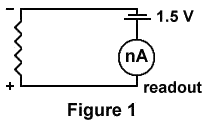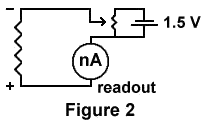"Geophysical Sensor"
(Return to Index Page)
Preliminary Patent Application
August 23, 1980
Coronado, California
Copyrighted © by The Townsend Brown family. All rights reserved.



This patent relates to a class of portable sensing devices
believed to be useful in geophysical prospecting. It is based in principle
on a phenomenon in physics not, as yet, fully understood; namely, "the
anomalous variation in electrical resistivity of long wires." It is
believed that such variations are caused by an incident penetrating
radiation coming (in part) from rock formations deep within the earth.
In its practical application, the sensor comprises (in
combination) a wirewound (preferably non-inductive) resistor, of extremely
high resistivity (approx. 1 megohm), electrically-coupled to a low voltage
battery and suitable readout (in the nano-ampere range).

The circuit shown in Fig. 1 represents the simplest form of the
invention. Unfortunately, such a circuit is commonly used in measuring
resistance and, therefore, probably not patentable per se. Certain additions
to the circuit may provide patentability and, at the same time, increase its
effectiveness and utility as a geophysical sensor. Such a circuit a shown
in Fig. 2.

Here, a voltage divider is provided to reduce the battery
voltage bellow the (1.5 volt) normal value. The advantage is as follows:
In the research (of this phenomenon) to date, it has been
discovered that "long-wire" resistors, including also certain dielectric
materials and semi-conductors, generate spontaneously a low-order
counter-emf when conducting a current.
This counter-emf (believed to be produced by a penetrating
incident radiation from an outside source) bucks the current from the
battery causing what appears to be an increase in resistance. In certain
instances, the counter-emf may equal or exceed the battery voltage, thus
providing a null, or reversed, polarity. The technique of indicating the
null position would provide increased sensitivity to the method and, since
the use of a "null" is not utilized in conventional methods for measuring
resistance, its use here may provide patentability.
In short, the indication and measurement of the shift in the
null position would provide a measure of the intensity of sub-surface
geophysical radiation. Such radiation (the nature of which has still not
been determined in the on-going investigations) is believed to be, in large
measure, emitted by or dependent upon rock composition or structure. Hence,
the sensor may provide information useful in prospecting for oil or mineral
deposits or in locating geo-thermal reservoirs.
In the design of such a sensor, it is important to use wires
(metals or other materials) which have minimum temperature effects. Many
commercially available resistors are so compensated. When not so
compensated, a constant-temperature housing must be provided.
Also, non-inductive windings (of resistors) are indicated where
possible. Otherwise, magnetic shielding may be necessary.
 Claims
Claims:
1. Method of observing penetrating radiation consisting in
providing, in combination, a metallic conductor, a source of direct current,
and current measuring means, connecting the same in series, and observing
the departure from normal of the electrical conductivity of said
conductor.
2. Method as in Claim 1 using semi-conducting materials as
conductors.
3. Method as in Claim 1 using rocks as conducting materials.
4. Method as in Claim 1 using partially-conducting oils as
conducting materials.
5. A geophysical sensor comprising a wire-wound resistor, a
source of direct current and current measuring means.
6. A geophysical sensor comprising a temperature-compensated
wire-wound resistor, a variable source of direct current and
current-measuring means.
7. A geophysical sensor as in Claim 5 using semi-conducting
materials in place of wire-wound resistors.


 Please be advised that this document is copyrighted © by The Townsend Brown family. All rights reserved.
Please see Legal and Copyright Information for additional copyright information.
Please be advised that this document is copyrighted © by The Townsend Brown family. All rights reserved.
Please see Legal and Copyright Information for additional copyright information.







